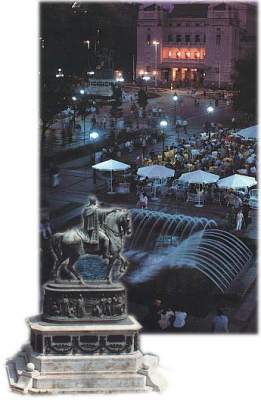 The space between the Gradska Kafana (City Restaurant), Jadran cinema, National Theatre and VJ Hall. The present-day square was laid out after the demolition of the Stambol Gate in 1866 and the construction of the National Theatre in 1869. The Gate had been built by the Austrians at the beginning of the 18th century, and stood in the area between the present sites of the monument to Prince Mihailo and the National Theatre building. It was the largest and most handsome of the town gates at the time when Belgrade was encircled by the moat. It was named after the road which led through it - to Constantinople (Istanbul). The Stambol Gate remained seared on people's memory as the place in front of which the Turks executed the raja, their non-Muslim subjects, by impaling them on stakes. It was also the place where during the attack on Belgrade in 1806 as part of the first Serbian uprising, one of the leading Serb military commanders, Vasa Carapic, was fatally wounded. In memory of this sad event, a street leading from the square and a monument in the vicinity were named after him. After the establishment of Serbian rule and the demolition of the Stambol Gate, the site of the present square was not laid out for a long time. The National Theatre was the only large building standing here for more than thirty years. The square gradually started to acquire more buildings after the monument to Prince Mihailo had been erected in 1882. The site of the present-day National Museum was the location of long single-storey building which housed, among other things, the famous Dardaneli restaurant. This was the meeting-place of members of the literary, theatrical and artistic circles of the time. The building was pulled down to make way in 1903 for the Treasury, which now houses the National Museum. Across the road in a small park next to the National Theatre, there was the wellknown Kolarac restaurant and cinema. It was owned by Ilija Milosavljević - Kolarac, a merchant who was something of a benefactor, and remained here right up to the Second World War. On the other side of the square, the Riunione Palace, in which the Jadran cinema can now be found, was built in 1930. The square gained its final appearance at the end of the 1980s, when greenery and fountains were installed, and the reconstruction of the National Theatre was completed. 

Albania Palace Building | The Bajrakli Mosque | Belgrade Palace Building | Belgrade Railway Station | Captain Miša's Building | Cvijeta Zuzorić Art Pavilion | Karađorđeva Street | Knez Mihailova Street | Princess Ljubica's Residence | Millenary Monunemt on Gardoš Hill | Price Miloš's Residence | The National Theatre | Nemanjina Street | Nikola Pašic Square | Republic Square | Skadarlija | Slavija Square | Student Square | The Trade Union Hall | Terazije Square | The '?' Cafe Restaurant | Article about the architecture and building in Belgrade |